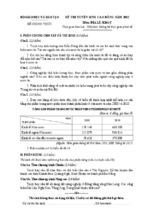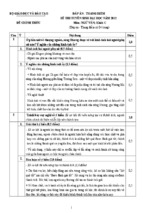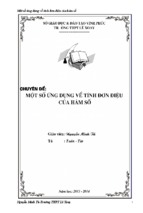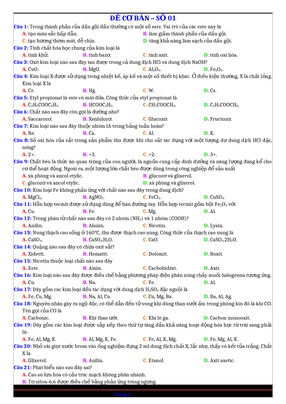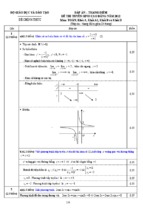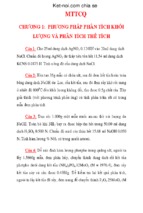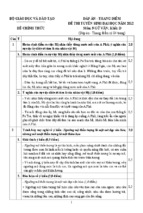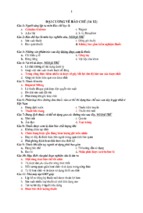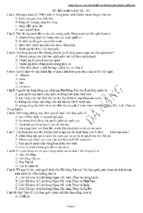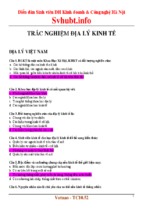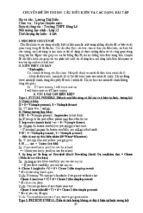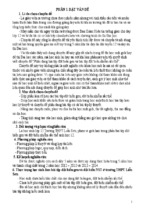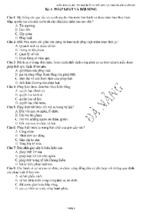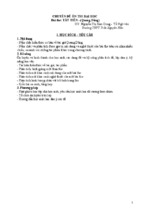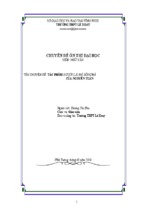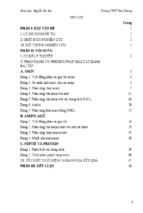B ĐỀ THI TH THPT QUỐC GIA
2020 MÔN TIẾNG ANH CÁC TRƯỜNG
TRONG CẢ NƯỚC
(CÓ ĐÁP ÁN VÀ GI I CHI TI T)
SỞ GD & ĐT
ĐỀ KIỂM TRA CHẤT LƯỢNG LẦN 1 – KHỐI 12
TRƯỜNG THPT HÀN THUYÊN
NĂM HỌC: 2019 – 2020
50 câu trắc nghiệm
MÔN: TIẾNG ANH
Thời gian làm bài: 60 phút; không kể thời gian phát đề
Blacken the letter A, B, C, or D on your answer sheet to indicate the correct answer to each of the
following questions.
Câu 1: Do you know that ________ longest river in ________ world is ________ Nile?
A. the/the/the
B. a/the/the
C. x/the/a
D. the/the/x
Câu 2: Lightweight luggage enables you to manage easily even when fully ________.
A. crowded
B. loaded
C. carried
D. packed
Câu 3: The revolving door remained ________ because Posey was pushing on it the wrong way.
A. station
B. stationed
C. stationary
D. stationery
Câu 4: ________ at the airport more early, he would have met his friend.
A. Then he arrived
B. Had he arrived
C. When he arrived
D. He has arrived
Câu 5: You must have forgotten to send the email, ________ there’s nothing in my inbox.
A. because of
B. for
C. due to
D. owning to
Câu 6: The wine had made him a little ________ and couldn’t control his movement.
A. light-headed
B. narrow-minded
C. light-hearted
D. light-footed
Câu 7: My little girl is tired now because she ________ all day.
A. studies
B. studied
C. has been studying
D. has studied
Câu 8: The new director has really got things ________.
A. flying
B. running
C. jogging
D. moving
Câu 9: ________________________, he left the hall quickly.
A. Not be rewarded with a smile
B. Not rewarding with a smile
C. Not having rewarded with a smile
D. Not being rewarded with a smile
Câu 10: We were ________ a mile of our destination when we ran out of petrol.
A. hardly
B. only
C. within
D. inside
Câu 11: The forecast has revealed that the world’s reserves of fossil fuel will have ________ by 2015.
A. taken over
B. caught up
C. run out
D. used off
Câu 12: I usually buy my clothes ________. It’s cheaper than going to the dress maker.
A. on the shelf
B. on the house
C. in public
D. off the peg
Câu 13: As ________ in Greek and Roman mythology, harpies were frightful monsters that were half
woman and half bird.
A. description
B. describing
C. to describe
D. described
Trang 1
Câu 14: Scientists have invented walls and windows that can block out the noise, which allows
individuals to focus on their work without ________.
A. be disturbed
B. disturbing
C. being disturbed
D. being disturbing
Blacken the letter A, B, C, or D on your answer sheet to show the underlined part that needs correction
Câu 15: Televisions are now an everyday feature of most households in the United States, and television
viewing is the number of one activity leisure.
A. everyday
B. activity leisure
C. most households
D. television viewing
Câu 16: New sources of energy have been looking for as the number of fossil fuels continues to decrease.
A. New sources
B. been looking
C. fossil
D. continues
Câu 17: Almost poetry is more enjoyable when it is read aloud.
A. is more
B. Almost
C. it is
D. enjoyable
Read the following passage and blacken the letter A, B, C, or D on your answer sheet to indicate the
correct answer to the following questions.
Foot racing is a popular activity in the United States. It is seen not only as a competitive sport but
also as a way to exercise, to enjoy the camaraderie of like-minded people, and to donate money to a
good cause. Though serious runners may spend months training to compete, other runners and walkers
might not train at all. Those not competing to win might run in an effort to beat their own time or simply
to enjoy the fun and exercise. People of all ages, from those of less than one year (who may be pushed in
strollers) to those in their eighties, enter into this sport. The races are held on city streets, on college
campuses, through parks, and in suburban areas, and they are commonly 5 to 10 kilometers in length.
The largest foot race in the world is the 12-kilometer Bay to Breakers race that is held in San Francisco
every spring. This race begins on the east side of the city near San Francisco Bay and ends on the west
side at the Pacific Ocean. There may be 80,000 or more people running in this race through the streets and
hills of San Francisco. In the front are the serious runners who compete to win and who might finish in as
little as 34 minutes. Behind them are the thousands 20 who take several hours to finish. In the back of the
race are those who dress in costumes and come just for fun. One year there was a group of men who
dressed like Elvis Presley, and another group consisted of firefighters who were tied together in a long
line and who were carrying a fire hose. There was even a bridal party, in which the bride was dressed in a
long white gown and the groom wore a tuxedo. The bride and groom threw flowers to bystanders, and
they were actually married at some point along the route.
Câu 18: Which of the following best describes the organization of this passage?
A. chronological order
B. cause and result
C. statement and example
D. specific to general
Câu 19: The main purpose of this passage is to ________________________.
A. describe a popular activity
B. give reasons for the popularity of the foot races
C. make fun of runners in costume
D. encourage people to exercise
Trang 2
Câu 20: In what sentence(s) does the author give reasons for why people enter foot races?
A. Foot racing … and exercise.
B. Behind them … a fire horse.
C. The largest … 34 minutes.
D. People of all ages … in length.
Câu 21: Which of the following is NOT implied by the author?
A. Foot races appeal to a variety of people
B. Walkers can compete for prizes
C. Entering a race is a way to give support to an organization
D. Running is a good way to strengthen the heart
Câu 22: The word “bystander” refers to __________.
A. a spectator
B. a judge
C. a participant
D. a walker
Câu 23: The phrase “to a good cause” could be best replaced by which of the following?
A. to reward the winner
B. to protect a wise investment
C. for a good purpose
D. for an award
Câu 24: Which of the following is NOT mentioned in this passage?
A. Some runners were ready to put out a fire
B. Some runners looked like Elvis Presley
C. Some runners were participating in a wedding
D. Some runners were serious about winning
Câu 25: The word “camaraderie” as used in line 2 could be best replaced by which of the following
_______.
A. views
B. companionship
C. games
D. jokes
Blacken the letter A, B, C, or D on your answer sheet to indicate the word or phrase that is OPPOSITE
in meaning to the underlined part in each of the following questions.
Câu 26: I think it’s impossible to abolish school examinations. They are necessary to evaluate students’
progress.
A. continue
B. extinguish
C. organize
D. stop
Câu 27: He revealed his intentions of leaving the company to the manager during the office dinner party.
A. concealed
B. disclosed
C. misled
D. influenced
Read the following passage and blacken the letter A, B, C, or D on your answer sheet to indicate the
correct word for each of the blanks in the following questions.
ABROAD WITH US
The company study abroad was originally founded in 1991 for students who wished to study French
in France. Its success led to the establishment of other schools around the world.
Learning the language in the country in which it is spoken is, of course, a (28) ________ more
effective and faster process than studying in your own country. It is also an opportunities to mix with
local habitants and (29) ________ a greater and deeper (30) ________ of the people whose language you
Trang 3
are studying. This makes the whole experience much more enjoyable. You may wish to attend an Italian
language and a cooking course in Italy or combine a Portuguese course with a sport. You should look at
all the possibilities and (31) ________ the best choice. In order to choose the (32) ________ course and
location for you, we suggest you contact us to discuss your particular requirements. From the information
you give us, we can make some recommendation.
Câu 28:
A. lots
B. far
C. so
D. very
Câu 29:
A. acquire
B. require
C. inquire
D. enquire
Câu 30:
A. know
B. knowledgeable
C. knowledge
D. knowledgeably
Câu 31:
A. do
B. make
C. take
D. get
Câu 32:
A. exact
B. right
C. precise
D. fit
Blacken the letter A, B, C, or D on your answer sheet to indicate the sentence that is closest in meaning
to each of the following questions.
Câu 33: “I’m sorry I gave you the wrong number”, said Paul to Susan.
A. Paul apologized to Susan for having given the wrong number.
B. Paul accused Susan of having given him the wrong number.
C. Paul thanked to Susan for giving the wrong number.
D. Paul denied giving Susan the wrong number.
Câu 34: I needn’t have watered the garden because it came down in torrents after that.
A. If only I had watered the garden before it came down in torrents.
B. It’s a pity I had watered the garden before it came down in torrents.
C. I regret having watered the garden before it came down in torrents.
D. If it had came down in torrents, I wouldn’t have watered the garden.
Câu 35: The students complained that the teacher was inexperienced.
A. The teacher was popular despite his inexperience.
B. The teacher was favored because of his inexperience.
C. The students praised the teacher for his inexperience.
D. The teacher was not supported for his inexperience.
Blacken the letter A, B, C, or D on your answer sheet to indicate the sentence that best combines each
pair of sentences in the following questions.
Câu 36: We gain more knowledge about how to stay safe online. We worry about the threats of
cybercrime less.
A. The more knowledge about how to stay safe online we gain, the more we worry about the threats of
cybercrime.
B. The more we stay online to gain safety knowledge, the less we worry about the threats of
cybercrime.
Trang 4
C. The more knowledge about how to stay safe online we gain, the less we worry about the threats of
cybercrime.
D. The more we know about how to stay safe online, we worry about the threats of cybercrime less.
Câu 37: We arrived at the airport. We realized our passports were still at home.
A. Not until we arrived at the airport, did we realize that our passports were still at home.
B. We arrived at the airport and realized that our passports are still at home.
C. Not until had we arrived at the airport, we realized our passports were still at home.
D. It was until we arrived at the airport that we realize our passports were still at home.
Blacken the letter A, B, C, or D on your answer sheet to indicate the word or phrase that is CLOSEST
in meaning to the underlined part in each of the following questions.
Trả lời cho các câu 38, 39 dưới đây:
Câu 38: He was sacked from his job after the manager discovered that he had stolen some money from
his colleagues.
A. dismissed
B. ejected
C. evicted
D. dropped
Câu 39: She simply took it for granted that the check was good and did not ask him any questions about
it.
A. objected to it
B. permitted it
C. looked it over
D. accepted it without investigation
Blacken the letter A, B, C, or D on your answer sheet to indicate the word with the main stress
different from that of the other three words in each question.
Câu 40:
A. escape
B. before
C. enough
D. welfare
Câu 41:
A. situation
B. examination
C. generation
D. education
Read the following passage and blacken the letter A, B, C, or D on your answer sheet to indicate the
correct answer to the following questions.
Very few people in the modern world obtain their food supply by hunting and gathering in the
natural environment surrounding their homes. This method of harvesting from nature’s provision is the
oldest known subsistence strategy and has been practised for at least the last two million years. It was,
indeed, the only way to obtain food until rudimentary farming and the domestication of wild animals
were introduced about 10,000 years ago.
Because hunter-gatherers have fared poorly in comparison with their agricultural cousins, their
numbers have dwindled, and they have been forced to live in marginal environments, such as deserts and
arctic wastelands. In higher latitudes, the shorter growing seasons have restricted the availability of plant
life. Such conditions have caused a greater dependence on hunting, and on fishing along the coasts and
waterways. The abundance of vegetation in the lower latitudes of the tropics, on the other hand, has
provided a greater opportunity for gathering a variety of plants. In short, the environmental differences
have restricted the diet and have limited possibilities for the development of subsistence societies.
Trang 5
Contemporary hunter-gatherers may help us understand our prehistoric ancestors. We know from
the observation of modern hunter-gatherers in both Africa and Alaska that a society based on hunting and
gathering must be very mobile. While the entire community camps in a central location, a smaller party
harvests the food within a reasonable distance from the camp. When the food in the area has become
exhausted, the community moves on to exploit another site. We also notice seasonal migration patterns
evolving for most hunter-gatherers, along with a strict division of labor between the sexes. These patterns
of behavior may be similar to those practised by mankind during the Paleolithic Period.
Câu 42: The word “domestication” in the first paragraph mostly means ________.
A. making wild animals used to living with and working for humans
B. hatching and raising new species of wild animals in the home
C. teaching animals to do a particular job or activity in the home
D. adapting animals to suit a new working environment
Câu 43: According to the passage, subsistence societies depend mainly on ________.
A. hunter-gatherers’ tools
B. agricultural products
C. farming methods
D. nature’s provision
Câu 44: In the lower latitudes of the tropics, hunter-gatherers ________.
A. can free themselves from hunting
B. live along the coasts and waterways for fishing
C. have better food gathering from nature
D. harvest shorter seasonal crops
Câu 45: typical feature of both modern and prehistoric hunter-gatherers is that ________.
A. they live in the forests for all their life
B. they don’t have a healthy and balanced diet
C. they don’t have a strong sense of community
D. they often change their living places
Câu 46: Which of the following would serve as the best title of the passage?
A. Evolution of Humans’ Farming Methods
B. Hunter-gatherers and Subsistence Societies
C. A Brief History of Subsistence Farming
D. Hunter-gatherers: Always on the Move
Blacken the letter A, B, C, or D on your answer sheet to indicate the word whose underlined part is
pronounced differently from the other three in each question.
Câu 47:
A. wicked
B. beloved
C. learned
D. cooked
Câu 48:
A. shame
B. drank
C. cable
D. blaze
Blacken the letter A, B, C, or D on your answer sheet to indicate the correct answer to each of the
following questions.
Câu 49: Joanne: “You should have flown with the earlier flight!”
Alex: “____________.”
A. Why not?
B. Oh, I’m sorry to hear that
C. It was fully booked
D. Yes. I did
Trang 6
Câu 50: Helen and Mary are talking about Mary’s result at school.
Helen: “Your parents must be proud of your result at school!”
Mary: “____________.”
A. Of course
B. I’m glad you like it
C. Sorry to hear that
D. Thanks. It’s certainly encouraging
Đáp án
1-D
2-D
3-C
4-B
5-B
6-A
7-C
8-D
9-D
10-C
11-C
12-D
13-D
14-C
15-B
16-B
17-B
18-C
19-A
20-A
21-D
22-A
23-C
24-A
25-B
26-A
27-A
28-B
29-A
30-C
31-B
32-B
33-A
34-C
35-D
36-C
37-A
38-A
39-D
40-D
41-B
42-A
43-D
44-C
45-D
46-B
47-D
48-B
49-C
50-D
LỜI GIẢI CHI TIẾT
Câu 1: Đáp án D
Phương pháp giải:
Kiến thức: Mạo từ
Giải chi tiết:
Mạo từ “the” dùng trong cấu trúc:
- So sánh nhất: the + adj-est/ most adj
- the + N (được cho là duy nhất): the world, the sun, the moon, …
Không dùng mạo từ trước tên núi, hồ, đường phố.
Tạm dịch: Bạn có biết rằng con sông dài nhất thế giới là sông Nin không?
Câu 2: Đáp án D
Phương pháp giải:
Kiến thức: Từ vựng
Giải chi tiết:
A. crowded (adj): đông đúc, chật ních
B. loaded (adj): nặng nề, gay go
C. carried (adj): được mang theo
D. packed (adj): nhồi nhét
Tạm dịch: Hành lý nhẹ cho phép bạn quản lý dễ dàng ngay cả khi nó được nhồi nhét đầy đồ.
Câu 3: Đáp án C
Phương pháp giải:
Kiến thức: Từ loại
Giải chi tiết:
A. station (n): trạm, điểm, đồn
Trang 7
B. stationed => không tồn tại
C. stationary (adj): đứng ở một chỗ, không chuyển động
D. stationery (n): đồ dùng văn phòng
Dấu hiệu: sau động từ “remained” (vẫn) cần một tính từ
Tạm dịch: Cánh cửa quay vẫn đứng yên vì Posey đang đẩy nó sai cách.
Câu 4: Đáp án B
Phương pháp giải:
Kiến thức: Đảo ngữ câu điều kiện loại 3
Giải chi tiết:
- Dấu hiệu: mệnh đề chính chia “would have + P2”
- Cách dùng: Câu điều kiện loại 3 dùng để diễn tả một giả thiết trái ngược với thực tế đã xảy ra ở quá khứ
- Công thức: If S + had + Ved/ V3 + O, S + would/ could + have + Ved/ V3 + O.
- Đảo ngữ câu điều kiện loại 3: Had + S + (not) + Ved/ V3, S + would/ could have + Ved/ V3.
Tạm dịch: Nếu anh ấy đến sân bay sớm hơn, thì anh ấy đã gặp bạn anh ấy rồi.
Câu 5: Đáp án B
Phương pháp giải:
Kiến thức: Liên từ
Giải chi tiết:
A. because of + N/ Ving: bởi vì
B. for S + V: vì, bởi vì
C. due to + N/ Ving: bởi vì
D. owning to + N/ Ving: bởi vì
“there’s nothing in my box” là một cụm S – V => loại A, C, D
Tạm dịch: Bạn chắc hẳn là đã quên gửi thư điện tử, vì không có gì trong hộp thư đến của tôi.
Câu 6: Đáp án A
Phương pháp giải:
Kiến thức: Từ vựng
Giải chi tiết:
A. light-headed (adj): không tỉnh táo
B. narrow-minded (adj): hẹp hòi, nhỏ nhen
C. light-hearted (adj): vui vẻ, vô tư
D. light-footed (adj): nhanh chân, nhanh nhẹn
Tạm dịch: Rượu đã làm cho anh ta mất tỉnh táo và không thể tự kiểm soát chuyển động của chính mình.
Câu 7: Đáp án C
Phương pháp giải:
Kiến thức: Thì hiện tại hoàn thành tiếp diễn
Trang 8
Giải chi tiết:
- Dấu hiệu: “all day” (suốt cả ngày)
- Cách dùng: Thì hiện tại hoàn thành tiếp diễn được sử dụng để nói về những hành động xảy ra trong quá
khứ nhưng vẫn còn tiếp tục ở hiện tại - nhấn mạnh tính liên tục của hành động - và có thể vẫn còn tiếp
diễn trong tương lai.
- Công thức: S + have/ has been + Ving.
Tạm dịch: Cô bé của tôi bây giờ mệt mỏi vì học suốt cả ngày.
Câu 8: Đáp án D
Phương pháp giải:
Kiến thức: Thành ngữ
Giải chi tiết:
A. flying (adj): bay, biết bay, mau chóng
B. running (adj): tiến hành trong lúc chạy, di động
C. jogging (n): sự đẩy nhẹ, sự lắc nhẹ
D. moving (adj): cảm động, làm mủi lòng
=> get things moving: tạo ra sự tiến bộ
Tạm dịch: Giám đốc mới đã thực sự tạo ra những sự tiến bộ.
Câu 9: Đáp án D
Phương pháp giải:
Kiến thức: Rút gọn mệnh đề trạng ngữ
Giải chi tiết:
Khi có 2 chủ ngữ giống nhau => rút gọn:
- dùng Ving: khi mệnh đề mang nghĩa chủ động
- dùng Not being V_ed/V cột 3: khi mệnh đề mang nghĩa bị động (đứng đầu câu)
Câu đầy đủ: When he wasn’t rewarded with a smile, he left the hall quickly.
Câu rút gọn: Not being rewarded with a smile, he left the hall quickly.
Tạm dịch: Không được thưởng với một nụ cười, anh nhanh chóng rời khỏi hội trường.
Câu 10: Đáp án C
Phương pháp giải:
Kiến thức: Từ vựng
Giải chi tiết:
A. hardly (adv): khắc nghiệt, khó khăn, vừa mới, hầu như không => không phù hợp nghĩa câu
B. only (adv): chỉ => không phù hợp nghĩa câu
C. within (adj): trong vòng
D. inside (adj): ở trong, trong nội bộ => không phù hợp nghĩa câu
Tạm dịch: Chúng tôi đã đi trong vòng một dặm đến đích đến khi hết xăng.
Trang 9
Câu 11: Đáp án C
Phương pháp giải:
Kiến thức: Cụm động từ
Giải chi tiết:
A. taken over: chịu trách nhiệm điều hành
B. caught up: làm bù để bắt kịp công việc đã lỡ, bắt kịp, đuổi kịp ai
C. run out: hết, cạn sạch
D. used off => không tồn tại
Tạm dịch: Dự báo đã tiết lộ rằng trữ lượng nhiên liệu hóa thạch trên thế giới sẽ hết vào năm 2015.
Câu 12: Đáp án D
Phương pháp giải:
Kiến thức: Thành ngữ
Giải chi tiết:
A. on the shelf : xếp xó, bỏ đi
B. on the house: miễn phí, không tính tiền
C. in public: giữa công chúng, công khai
D. off the peg: may sẵn (quần áo)
Tạm dịch: Tôi thường mua quần áo may sẵn. Nó rẻ hơn so với việc đến chỗ may đo quần áo.
Câu 13: Đáp án D
Phương pháp giải:
Kiến thức: Rút gọn mệnh đề trạng ngữ
Giải chi tiết:
Khi có 2 chủ ngữ giống nhau => rút gọn:
- dùng Ving: khi mệnh đề mang nghĩa chủ động
- dùng V_ed/V cột 3: khi mệnh đề mang nghĩa bị động
Và giữ lại trạng từ.
Câu đầy đủ: As harpies were described in Greek and Roman mythology, they were frightful monsters
that were half woman and half bird.
Câu rút gọn: As described in Greek and Roman mythology, they were frightful monsters that were half
woman and half bird.
Tạm dịch: Theo được mô tả trong thần thoại Hy Lạp và La Mã, những con yêu quái là những con quái
vật đáng sợ là một nửa phụ nữ và một nửa con chim.
Câu 14: Đáp án C
Phương pháp giải:
Kiến thức: to V/ Ving
Giải chi tiết:
Trang 10
without + V_ing: không làm gì
without + being Ved/ V cột 3: không bị làm gì
Tạm dịch: Các nhà khoa học đã phát minh ra các bức tường và cửa sổ có thể ngăn chặn tiếng ồn, cho
phép các cá nhân tập trung vào công việc của họ mà không bị làm phiền.
Câu 15: Đáp án B
Phương pháp giải:
Kiến thức: Từ vựng
Giải chi tiết:
leisure activity: hoạt động lúc rảnh rỗi
Sửa: activity leisure => leisure activity
Tạm dịch: Ti vi là một đặc trưng hàng ngày của hầu hết các hộ gia đình ở Hoa Kỳ và xem truyền hình là
một trong những hoạt động giải trí.
Câu 16: Đáp án B
Phương pháp giải:
Kiến thức: Câu bị động
Giải chi tiết:
- Dấu hiệu: “New sources of energy” (Các nguồn năng lượng mới) chịu tác động của hành động “look”
(tìm thấy)
- Câu bị động thì hiện tại hoàn thành: S + have/ has been + Ved/ V3.
Sửa: been looking => been looked
Tạm dịch: Các nguồn năng lượng mới đã được tìm kiếm vì số lượng nhiên liệu hóa thạch tiếp tục giảm.
Câu 17: Đáp án B
Phương pháp giải:
Kiến thức: Từ loại
Giải chi tiết:
- Dấu hiệu: trước danh từ “poetry” (thơ ca) cần một tính từ
- Almost (adv): hầu như, gần như => bổ nghĩa cho động từ, tính từ hoặc một trạng từ khác.
Almost thường đi với: anybody, anything, no one, nobody, all, everybody, every.
- Most (adj): hầu hết, phần lớn, đa số => chỉ bổ nghĩa cho danh từ
Most + N (không xác định)
Sửa: Almost => Most
Tạm dịch: Hầu hết thơ ca đều thú vị hơn khi được đọc to.
Câu 18: Đáp án C
Phương pháp giải:
Kiến thức: Đọc hiểu
Giải chi tiết:
Trang 11
Điều nào sau đây mô tả đúng nhất về tổ chức của đoạn văn này?
A. thứ tự thời gian
B. nguyên nhân và kết quả
C. trình bày và ví dụ
D. cụ thể cho chung
Thông tin: Foot racing is a popular activity in the United States… The largest foot race in the world is
the 12-kilometer Bay to Breakers race that is held in San Francisco every spring.
Tạm dịch: Chạy đua là một hoạt động phổ biến ở Hoa Kỳ… Cuộc chạy đua lớn nhất thế giới là cuộc đua
Bay tới Breakers dài 12 km được tổ chức tại San Francisco vào mỗi mùa xuân.
Câu 19: Đáp án A
Phương pháp giải:
Kiến thức: Đọc hiểu
Giải chi tiết:
Mục đích chính của đoạn văn này là để _______________.
A. mô tả một hoạt động phổ biến
B. đưa ra lý do cho sự phổ biến của các cuộc chạy đua
C. tạo niềm vui cho người chạy bộ mặc trang phục (theo phong cách nào đó)
D. khuyến khích mọi người tập thể dục
Thông tin: Foot racing is a popular activity in the United States.
Tạm dịch: Chạy đua là một hoạt động phổ biến ở Hoa Kỳ.
Câu 20: Đáp án A
Phương pháp giải:
Kiến thức: Đọc hiểu
Giải chi tiết:
Trong câu nào tác giả đưa ra lý do tại sao mọi người tham gia cuộc chạy đua?
A. Chạy đua … và tập thể dục.
B. Đằng sau họ … một con ngựa lửa.
C. Trận đấu lớn nhất … 34 phút.
D. Mọi người ở mọi lứa tuổi … chiều dài.
Thông tin: Foot racing is a popular activity in the United States. It is seen not only as a competitive sport
but also as a way to exercise, to enjoy the camaraderie of like-minded people, and to donate money to a
good cause. Though serious runners may spend months training to compete, other runners and walkers
might not train at all. Those not competing to win might run in an effort to beat their own time or simply
to enjoy the fun and exercise.
Tạm dịch: Chạy đua là một hoạt động phổ biến ở Hoa Kỳ. Nó không chỉ được coi là một môn thể thao
cạnh tranh mà còn là một cách để tập thể dục, để tận hưởng tình bạn của những người cùng chí hướng và
Trang 12
quyên góp tiền cho một mục đích chính đáng. Mặc dù những người chạy bộ nghiêm túc có thể dành nhiều
tháng tập luyện để thi đấu, nhưng cũng có những người chạy bộ và đi bộ khác có thể không tập luyện gì
cả. Những người không cạnh tranh để giành chiến thắng có thể chạy trong một nỗ lực để đánh bại thời
gian của riêng họ hoặc chỉ đơn giản là để tận hưởng niềm vui và tập thể dục.
Câu 21: Đáp án D
Phương pháp giải:
Kiến thức: Đọc hiểu
Giải chi tiết:
Điều nào sau đây KHÔNG được tác giả ngụ ý?
A. Cuộc chạy đua thu hút nhiều người
B. Người đi bộ có thể cạnh tranh để giành giải thưởng
C. Tham gia một cuộc đua là một cách để hỗ trợ cho một tổ chức
D. Chạy là một cách tốt để giữ cho một trái tim khỏe
Thông tin: It is seen not only as a competitive sport but also as a way to exercise, to enjoy the
camaraderie of like-minded people, and to donate money to a good cause… People of all ages, from those
of less than one year (who may be pushed in strollers) to those in their eighties, enter into this sport.
Tạm dịch: Nó không chỉ được coi là một môn thể thao cạnh tranh mà còn là một cách để tập thể dục, để
tận hưởng tình bạn của những người cùng chí hướng và quyên góp tiền cho một mục đích chính đáng…
Mọi người ở mọi lứa tuổi, từ những bé dưới một tuổi (có thể được đẩy trong xe đẩy) đến những người ở
độ tuổi tám mươi, tham gia môn thể thao này.
Câu 22: Đáp án A
Phương pháp giải:
Kiến thức: Đọc hiểu
Giải chi tiết:
Từ “bystander” chỉ __________.
bystander (n): khán giả, người đứng xem
A. a spectator: một khán giả
B. a judge: một thẩm phán
C. a participant: một người tham gia
D. a walker: một người đi bộ
Thông tin: The bride and groom threw flowers to bystanders, and they were actually married at some
point along the route.
Tạm dịch: Cô dâu và chú rể ném hoa cho người đứng xem, và họ thực sự đã kết hôn tại một số điểm dọc
theo tuyến đường.
Câu 23: Đáp án C
Kiến thức: Đọc hiểu
Trang 13
Giải chi tiết:
Cụm từ “to a good cause” có thể được thay thế bằng cái nào sau đây?
to a good cause: cho một mục đích chính đáng
A. để thưởng cho người chiến thắng
B. để bảo vệ một khoản đầu tư khôn ngoan
C. cho một mục đích tốt
D. cho một giải thưởng
Thông tin: It is seen not only as a competitive sport but also as a way to exercise, to enjoy the
camaraderie of like-minded people, and to donate money to a good cause.
Tạm dịch: Nó không chỉ được coi là một môn thể thao cạnh tranh mà còn là một cách để tập thể dục, để
tận hưởng tình bạn của những người cùng chí hướng và quyên góp tiền cho một mục đích chính đáng.
Câu 24: Đáp án A
Kiến thức: Đọc hiểu
Giải chi tiết:
Điều nào sau đây KHÔNG được đề cập trong đoạn văn này?
A. Một số vận động viên đã sẵn sàng để dập lửa
B. Một số vận động viên trông giống như Elvis Presley
C. Một số vận động viên đang tham gia một đám cưới
D. Một số vận động viên nghiêm túc về chiến thắng
Thông tin: In the front are the serious runners who compete to win and who might finish in as little as 34
minutes… ne year there was a group of men who dressed like Elvis Presley, and another group consisted
of firefighters who were tied together in a long line and who were carrying a fire hose. There was even a
bridal party, in which the bride was dressed in a long white gown and the groom wore a tuxedo. The bride
and groom threw flowers to bystanders, and they were actually married at some point along the route.
Tạm dịch: Ở phía trước là những vận động viên nghiêm túc thi đấu để giành chiến thắng và có thể hoàn
thành trong ít nhất 34 phút… Một năm nọ, có một nhóm những người đàn ông ăn mặc như Elvis Presley
và một nhóm khác gồm các nhân viên cứu hỏa bị trói chặt vào nhau thành một hàng dài và đang mang
theo vòi cứu hỏa. Thậm chí còn có một bữa tiệc cô dâu, trong đó cô dâu mặc một chiếc váy dài màu trắng
và chú rể mặc một bộ tuxedo. Cô dâu và chú rể ném hoa cho những người đứng xem, và họ thực sự đã kết
hôn tại một số điểm dọc theo tuyến đường.
Câu 25: Đáp án B
Kiến thức: Đọc hiểu
Giải chi tiết:
Từ “camaraderie” được sử dụng trong dòng 2 có thể được thay thế tốt nhất bằng __________ .
camaraderie (n): tình bạn
A. views (n): tầm nhìn, quan điểm
Trang 14
B. companionship (n): tình bạn
C. games (n): trò chơi
D. jokes (n): chuyện cười, chuyện đùa
Thông tin: It is seen not only as a competitive sport but also as a way to exercise, to enjoy the
camaraderie of like-minded people, and to donate money to a good cause.
Tạm dịch: Nó không chỉ được coi là một môn thể thao cạnh tranh mà còn là một cách để tập thể dục, để
tận hưởng tình bạn của những người cùng chí hướng và quyên góp tiền cho một mục đích chính đáng.
Câu 26: Đáp án A
Kiến thức: Từ trái nghĩa
Giải chi tiết:
abolish (v): thủ tiêu, bãi bỏ, hủy bỏ
A. continue (v): tiếp tục, duy trì
B. extinguish (v): dập tắt, làm tiêu tan
C. organize (v): tổ chức
D. stop (v): ngừng, dừng lại
=> abolish >< continue
Tạm dịch: Tôi nghĩ rằng không thể hủy bỏ các kỳ thi ở trường. Chúng cần thiết để đánh giá sự tiến bộ
của sinh viên.
Câu 27: Đáp án A
Giải chi tiết:
reveal - revealed - revealed: bộc lộ, tiết lộ
A. conceal - concealed - concealed: giấu giếm, che đậy
B. disclose - disclosed - disclosed: vạch trần, phơi bày
C. mislead - misled - misled: làm cho lạc đường, làm cho lạc lối
D. influence - influenced - influenced: ảnh hưởng, tác động
=> reveal >< conceal
Tạm dịch: Anh ta tiết lộ ý định rời công ty cho người quản lý trong bữa tiệc tối tại văn phòng.
Câu 28: Đáp án B
Kiến thức: So sánh hơn
Giải chi tiết:
Công thức nhấn mạnh trong so sánh hơn: far/ much + more adj/ adj-er
Learning the language in the country in which it is spoken is, of course, a (28) far more effective and
faster process than studying in your own country.
Tạm dịch: Tất nhiên, học ngôn ngữ ở quốc gia nơi nó được nói là một quá trình hiệu quả và nhanh hơn
nhiều so với học tập tại đất nước của bạn.
Câu 29: Đáp án A
Trang 15
Kiến thức: Từ vựng
Giải chi tiết:
A. acquire (v): đạt được, giành được
B. require (v): đòi hỏi, yêu cầu, quy định
C. inquire (v): điều tra, hỏi thăm, hỏi mua
D. enquire (v): điều tra, hỏi thăm, hỏi mua
It is also an opportunities to mix with local habitants and (29) acquire
Tạm dịch: Đây cũng là một cơ hội để hòa hợp với các cư dân địa phương và có được
Câu 30: Đáp án C
Kiến thức: Từ loại
Giải chi tiết:
Dấu hiệu: sau tính từ ở dạng so sánh hơn “greater and deeper” (sâu rộng hơn) cần một danh từ
A. know (v): biết, hiểu
B. knowledgeable (adj): thông thạo, thành thạo
C. knowledge (n): kiến thức, sự hiểu biết
D. knowledgeably (adv): thông thạo, thành thạo
It is also an opportunities to mix with local habitants and acquire a greater and deeper (30) knowledge of
the people whose language you are studying.
Tạm dịch: Đây cũng là một cơ hội để hòa hợp với các cư dân địa phương và có được kiến thức sâu rộng
hơn về những người mà bạn đang học ngôn ngữ.
Câu 31: Đáp án B
Kiến thức: Từ vựng
Giải chi tiết:
A. do (v): làm, hành động
B. make (v): chế tạo, sản xuất
C. take (v): cầm, lấy
D. get (v): có được, lấy được
=> make choice: lựa chọn
You should look at all the possibilities and (31) make the best choice.
Tạm dịch: Bạn nên xem xét tất cả các khả năng và đưa ra lựa chọn tốt nhất.
Câu 32: Đáp án B
Kiến thức: Từ vựng
Giải chi tiết:
A. exact (adj): chính xác (trong mọi chi tiết)
B. right (adj): thích hợp
C. precise (adj): rõ ràng và chính xác
Trang 16
D. fit (adj): phù hợp (về kích cỡ, loại)
In order to choose the (32) right course and location for you, we suggest you contact us to discuss your
particular requirements.
Tạm dịch: Để chọn khóa học và địa điểm thích hợp cho bạn, chúng tôi khuyên bạn nên liên hệ với chúng
tôi để thảo luận về các yêu cầu cụ thể của bạn.
Câu 33: Đáp án A
Kiến thức: Câu tường thuật
Giải chi tiết:
Câu trực tiếp: “I’m sorry + I + V_ed/V cột 2”, S1 said to S2.
Câu gián tiếp: S1 apologized (to S2) for having + Ved/ V cột 3: Ai đó xin lỗi ai vì đã làm gì
Tạm dịch: “Tôi xin lỗi tôi đã đưa nhầm số cho bạn”, Paul nói với Susan.
= Paul xin lỗi Susan vì đã đưa nhầm số.
B. Paul buộc tội Susan đã đưa nhầm số cho anh ta. => sai về nghĩa
C. Paul cảm ơn Susan vì đã đưa nhầm số. => sai về nghĩa
D. Paul từ chối đưa cho Susan số sai. => sai về nghĩa
Câu 34: Đáp án C
Kiến thức: Cấu trúc đồng nghĩa
Giải chi tiết:
- Câu ước ở quá khứ dùng để diễn tả những mong ước về một sự việc không có thật ở quá khứ, hay giả
định một điều ngược lại so với thực tại đã xảy ra ở quá khứ, thường là để diễn tả sự nuối tiếc với tình
huống ở quá khứ.
Công thức chung: S + wish(es)/ If only + S + had + Ved/ PII + O.
- regret + Ving/ having Ved/ V3: hối tiếc vì đã làm gì
Tạm dịch: Tôi đáng lẽ không cần tưới nước cho khu vườn bởi vì trời đổ mưa ngay sau đó.
= Tôi rất tiếc vì đã tưới nước cho khu vườn trước khi trời đổ mưa.
A. Tôi ước tôi đã tưới nước cho khu vườn trước khi trời đổ mưa. => sai về nghĩa
B. Sai thì. Sau “it’s a pity” (thật tiếc) không dùng thì quá khứ hoàn thành
D. Nếu trời đã đổ mưa, thì tôi sẽ không phải tưới nước cho khu vườn. => sai về nghĩa
Câu 35: Đáp án D
Kiến thức: Cấu trúc đồng nghĩa
Giải chi tiết:
complain (v): phàn nàn
= tobe not supported: không được ủng hộ
Tạm dịch: Học sinh phàn nàn rằng giáo viên thiếu kinh nghiệm.
= Giáo viên không được ủng hộ vì thiếu kinh nghiệm.
A. Giáo viên nổi tiếng mặc dù thiếu kinh nghiệm. => sai về nghĩa
Trang 17
B. Giáo viên được ưa thích vì thiếu kinh nghiệm. => sai về nghĩa
C. Các sinh viên khen ngợi giáo viên về sự thiếu kinh nghiệm. => sai về nghĩa
Câu 36: Đáp án C
Kiến thức: So sánh kép
Giải chi tiết:
Công thức: The + more (adj/ adj-er/N) + S1 + V1, the + more (adj/ adj-er/N) + S2 + V2. càng… càng
Tạm dịch: Chúng tôi có thêm kiến thức về cách giữ an toàn trực tuyến. Chúng tôi lo lắng về các mối đe
dọa của tội phạm mạng ít hơn.
= Chúng tôi càng có nhiều kiến thức về cách giữ an toàn trực tuyến, chúng tôi càng ít lo lắng về các mối
đe dọa của tội phạm mạng.
A. Chúng tôi càng có nhiều kiến thức về cách giữ an toàn trực tuyến, chúng tôi càng lo lắng về các mối đe
dọa của tội phạm mạng. => sai về nghĩa
B. Chúng ta càng trực tuyến để có được kiến thức về an toàn, chúng ta càng ít lo lắng về các mối đe dọa
của tội phạm mạng. => sai về nghĩa
D. Sai công thức.
Câu 37: Đáp án A
Kiến thức: Đảo ngữ
Giải chi tiết:
- Công thức: It is/ was not until + trạng từ chỉ thời gian/mệnh đề + that... + S + V: Mãi cho đến….. thì…
- Đảo ngữ: Not until + S + V/ trạng từ chỉ thời gian + V(trợ) + S + V(chính): Mãi cho đến khi…
Tạm dịch: Chúng tôi đến sân bay. Chúng tôi nhận ra hộ chiếu của chúng tôi vẫn ở nhà.
= Mãi cho đến khi chúng tôi đến sân bay thì chúng tôi mới nhận ra rằng hộ chiếu của chúng tôi vẫn ở nhà.
B. Sai thì động từ: “are”
C. Sai thì động từ: “had we arrived”
D. Sai công thức.
Câu 38: Đáp án A
Kiến thức: Từ đồng nghĩa
Giải chi tiết:
sack - sacked - sacked: sa thải, cách chức
A. dismiss - dismissed - dismissed: giải tán, sa thải
B. eject - ejected - ejected: đuổi ra, tống ra
C. evict - evicted - evicted: đuổi
D. drop - dropped - dropped: rớt xuống, gục xuống
=> sack (v) = dismiss (v): sa thải, đuổi việc
Tạm dịch: Anh ta bị đuổi việc sau khi người quản lý phát hiện ra rằng anh ta đã ăn cắp một số tiền từ các
đồng nghiệp của mình.
Trang 18
- Xem thêm -


